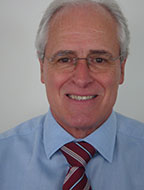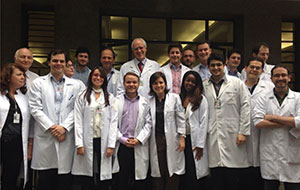By Ricardo Nitrini, MD

Ricardo Nitrini, MD
When I was invited to give the presentation “Successful Training in Neurology in Latin America” at the 2015 World Congress of Neurology in Santiago, Chile, I tried to answer the question, “What is the best way to train a neurologist in Latin America?”
To analyze the current situation, I emailed Latin American leaders in neurology, seeking information on graduate courses of medicine, residency programs and the number of neurologists in their countries. Most of my suggestions are based on more than 40 years of experience in clinical practice as a neurologist and in teaching neurology in a Latin American country. So, they are not scientifically proven assertions and should be regarded as a specialist’s opinion.
First, a well-trained Latin American neurologist should be able to provide the best treatment for patients with neurological diseases, teach all medical doctors to treat and recognize the most common neurological diseases that should be referred to neurologists, and research methods of the prevention, diagnosis and treatment of neurological diseases, mainly those that are more frequent in Latin American countries.
First step: Neurology in the Medical School

Ricardo Nitrini, MD (back row, center), faculty and residents from the University of Sà£o Paulo, Brazil, gather for a photo.
We need to attract the best medical students to be neurologists.1 To accomplish this, it’s important to fight “neurophobia” during the graduate course. Two main actions are important for this purpose – avoiding teaching excessive techniques of neurological examination in a short period of time and changing the old idea that neurology is great for diagnosis, but not for treatment. Neurologists can do much for their patients and will do much more in the near future.
Most Latin American medical schools do not have neurology departments. The information I received from seven Latin American countries showed that there were only 42 such departments in 307 medical schools, and the teaching of clinical neurology has been delivered by both neurologists and other medical doctors in the large majority of these schools. Thus, it’s important for medical schools to establish neurology departments and deliver instruction through trained neurologists.
The formation of Neurologists in Latin America
Most European countries require a four-year minimum of postgraduate training in neurology.2,3 This contrasts with postgraduate training in neurology in Latin American countries (minimum two years in Brazil and three years in the majority). In the U.S., residency programs are three years long (preceded by a year of internal medicine training).4
To obtain more successful training, we need to have longer residency programs (at least three years dedicated to clinical neurology) to incorporate the expanding field of neurological practice. We may also stimulate residents to undertake short-term elective training in other Latin American centers and abroad.
Research
It is essential to improve research on the prevention, diagnosis and treatment of neurological diseases in Latin America, particularly those more prevalent in Latin American countries. Neurologists should be trained during graduate and residency programs on basic aspects of medical research to be able to interpret results and conclusions of papers, and should learn how to submit and publish manuscripts in indexed journals.
More Well-trained Neurologists
The Neurology Atlas (WHO 2004) showed that the median number of neurologists per 100,000 in population varies widely across regions, from 0.03 in Africa to 4.84 in Europe. In the Americas, this figure was 0.89, but there was no specific data from Latin American countries.5 Information I received from 11 Latin American countries showed that this number ranges from 0.3 to 3.7, with a median of 0.9. The appropriate number of neurologists in the population depends upon the structure of a country’s health care system.4 In low-income countries, such as Latin American countries, there are large inequities across regions. In Brazil, for instance, the number of neurologists ranges from less than five in five of the 26 states to more than 200 in four states.6
We need more neurologists, but, as is frequent in several regions of the world, there are more applicants than positions for residency training in neurology.3
Conclusions
We need to attract the best medical students to become clinical neurologists, to extend the residency program time, to teach basic aspects of research on clinical neurology during residency programs, and to increase the positions for residency programs in neurology in order to increase the number of well-trained neurologists. To reach this objective, we should develop combined actions of local neurological societies and public health authorities, and also to increase cooperation between Latin American countries and with developed countries.
Acknowledgements
I am grateful for information provided by Drs. Daniel Raú
l Zuin, Argentina; Juan Carlos Duran, Bolivia; Renato Verdugo, Chile; German Perez-Romero, Colombia; Guillermo Jiménez, Dominican Republic; Ildefonso Rodriguez Leyva, México; Walter Samuel Diaz, Nicaragua; Fernando Gracia, Panama; Nilton Custodio, Peru; and Santiago Fontiveros, Venezuela. •
References
- Russell Brain. Neurology: Past, present, and future. Br Med J 1958; 5067:355-360.
- Bergen DC, Good D. Neurology training program worldwide: a world federation of neurology survey. J Neurol Sci 2006;246:59-64.
- Steck A, Struhal W, Sergay SM, Grisold W, Education Committee World Federation of Neurology. The global perspective on neurology training: the world federation of neurology survey. J Neurol Sci 2013;334:30-47.
- http://www2.massgeneral.org/neurologyresidents/program/curriculum.html
- Atlas. Country Resources for Neurological Disorders 2004. Geneva: World Health Organization and World Federation of Neurology, 2004.
- Amorim HA, Scorza CA, Cavalheiro EA, Albuquerque M, Scorza FA. Profile of neurologists in Brazil; a glimpse into the future of epilepsy and sudden unexpected death in epilepsy. Clinics 2013;68:896-898.
